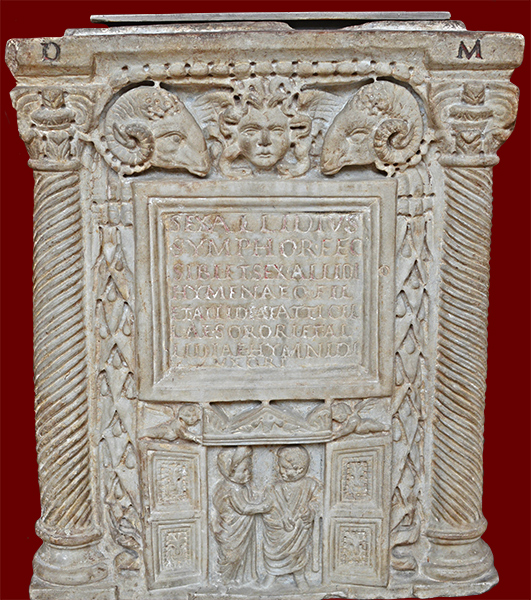
Marble cinerary urn of a family freed by the Allidii, Rome, 120-150 CE
Detail of dextrarum iunctio
This well-preserved marble chest, carved in the shape of a shrine or small temple, pays tribute to a tightly knit extended family. Dating from the mid-second century CE, it was found in 1843 in Rome's Vigna Aquari, along with other cinerary urns (CIL 6.6821-6831), inside a columbarium belonging to the freedmen of the gens Allidia. It is one of three urns (see CIL 6.6827 and CIL 6.6829 below) belonging to members of a family who stayed together, passing from slavery in the household of the gens Allidia into freedom, and becoming sufficiently wealthy to immortalize themselves with several expensive memorials. At the heart of the family stand Allidia Hymnis, wife, mother, and sister-in-law, and Sextus Allidius Symphorus, husband, father, brother, and kinsman. Symphorus intended the opulently carved urn on the left for his own ashes and those of his freed son, Sextus Allidius Hymenaeus, his sister, Allidia Atticilla, and his legal wife (uxor) Hymnis (see names of freedpersons). In keeping with Roman social convention, family members are explicitly defined in terms of the father—filius, soror, uxor and cognati— but other connections— sister-in-law, nephew, and uncle, not to mention husband and father— although elided, suggest themselves to the viewer and trace the arc of a prosperous group of freedpersons who, despite their servile status, successfully inscribed themselves on their memorials as a legitimate and stable Roman family. The uppermost tier of the urn, just below the lid, is marked with the letters D and M, the abbreviation for Dis Manibus, the formula common on funerary monuments during the first two centuries CE that dedicated the remains of the deceased to the care of the spirits of the dead. While the Hellenistic-Roman funerary iconography (rams' heads and a Medusa head in the gable, rams' heads on the column capitals, framing garland of sacred ribbons and laurel leaves) marks the passage from life to death, the relief panel beneath the inscription tablet illustrates the defining moment for slaves who were legally manumitted— proof of their ability to contract a legitimate Roman marriage, symbolized by their exchange of right hands (dextrarum iunctio) in citizen dress, she in matronal attire and he in the toga of citizenship. The couple stand on the threshold between open doors whose panels are carved with four lions’ heads; above the doors float a pair of winged Cupids supporting a decorative pediment.
SEX[tus] ALLIDIVS
SYMPHOR[us] FEC[it] [hoc monumentum]
SIBI ET SEX[to] ALLIDI[O]
ET ALLIDIAE ATTICIL-
LIDIAE HYMNIDI
Hymnis and another Hymnis, the sister of Hymenaeus who was perhaps born after her mother had been manumitted, together commissioned a separate urn for Symphorus and his son Hymenaeus. While it attests to the ability of freedwomen to commission family monuments in their own name, it is not clear why another urn would have been commissioned. The urn, not pictured here, featured a pair of portrait busts, presumably of Symphorus and Hymenaeus, above which was a tympanum in which an eagle was carved.
Symphorus also dedicated a marble urn to his relatives, Sextus Allidius Soter and Allidia Eutychia, similarly freed by the Allidii. This set of inscriptions affords remarkable evidence of the close and enduring bonds between former slaves who were relatives by marriage as well as blood.
Click on the underlined words for translation aids and commentary, which will appear in a small window.